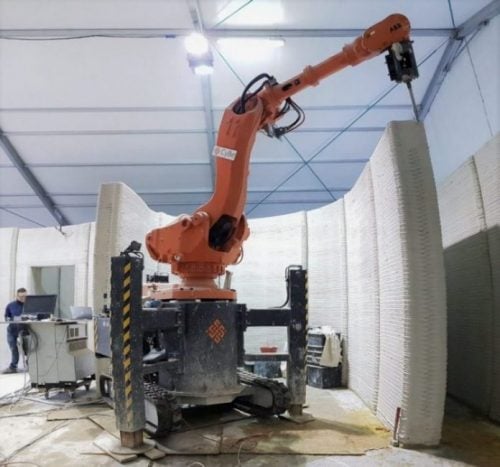![CyBe’s concrete 3D printer [Source: CyBe]](https://fabbaloo.com/wp-content/uploads/2020/05/image-asset_img_5eb09285de06d.jpg)
Today I’m looking at a company marketing a pair of construction 3D printers.
CyBe is a Netherlands-based company that grew out of a traditional construction firm that started almost 100 years ago. In recent years they were puzzled — as am I — as to why the construction industry has not undergone a process of automation as so many other industries have done.
Seeing no obvious options, they decided to embark on automating the industry themselves by introducing a line of construction 3D printers, or as they call them, concrete 3D printers.
The premise of a construction or concrete 3D printer is fairly simple: a normal concrete pump is attached to a computer-controlled motion system that allows the concrete deposition to be precisely controlled.
Some construction 3D printers use a gantry system, similar to what you might see on a desktop 3D printer, except far larger. But others, like CyBe, have opted for a robotic arm system. In their conception, the concrete extruder is mounted on the robot arm effector, which can move in six axes.
While the concept seems straightforward, there are all kinds of complications that the construction 3D printer company must work out in order to successfully 3D print large concrete objects. In a way, these complications are analogous to what a desktop 3D printer operator might face when tuning the system.
![CyBe’s concrete 3D printer concept [Source: CyBe]](https://fabbaloo.com/wp-content/uploads/2020/05/image-asset_img_5eb09286501ee.png)
Concrete Flow in 3D Printers
One issue is the concrete material itself. It must be sufficiently liquid to flow easily through the concrete pump with great reliability. You wouldn’t want to encounter a jam and “ruin” a print, which in this case could literally be a building. But at the same time, the material must be sufficiently viscous to maintain its shape without slumping when extruded. Of course, it also must be strong when cured, as well. CyBe has devised a concrete mix they call “MORTAR” that meets these requirements.
Another complication is what I would call “reach”. In a typical 3D printer there is always a “build volume”, the maximum extent to which an object can be created. This is because the build chamber literally surrounds the printed object. However, in the case of a robotic system such as is used by CyBe, the concept of a build volume is a bit different.
They say in their specifications that their machines have a “printing range” of 3.2m. That is essentially the maximum distance the robotic system can reach. For a smaller concrete object that would fit within this range, CyBe offers a “fixed” printer option. In this case the device is more-or-less permanently mounted in a position where it can 3D print concrete objects. This is likely best for a factory scenario, where the machine is used to print small concrete components that are shipped elsewhere for use.
Mobile Construction 3D Printing
The other option from CyBe is a “mobile” option. In this configuration the concrete 3D printer is mounted on an interesting platform with legs and tracks. The tracks allows it to be move from place to place, although I strongly suspect it prints only while stationary.
![CyBe’s concrete 3D printer showing mounting legs [Source: CyBe]](https://fabbaloo.com/wp-content/uploads/2020/05/image-asset_img_5eb0928705e81.jpg)
Here’s where another complication comes in: I’m pretty certain the concrete printer must be mounted level to ensure it properly understands the build space. This is likely accomplished through an adjustment of the legs on the mobile configuration.
Currently, CyBe is offering these two units at price levels one might expect for high-end construction equipment: €180K for the mobile version, and €150K for the fixed version. The price also includes training for the two personnel required to operate the devices.
This video shows the machine in action. I suspect it requires a bit of tuning as there appears to be extrusion challenges when 3D printing the corners of the structure at such high speeds:
Advanced Construction 3D Printing
CyBe has completed a series of projects with their equipment, and they feature galleries of images of them on their website. Most of the projects seem rather conventional, with flat walls and roofs, mostly indistinguishable from conventionally made structures. However, they have been working on far more advanced designs as well, such as this one:
![CyBe’s concrete 3D printer advanced building design [Source: CyBe]](https://fabbaloo.com/wp-content/uploads/2020/05/cybe-design-render_img_5eb0928793ea0.jpg)
Here we see how this technology could truly be leveraged to produce “impossible” structures. That’s what we’ve seen with desktop and factory 3D printers, so why not expect the same with construction 3D printers?
Via CyBe











COBOD’s BOD2 construction 3D printer seems to be catching on as the company has made multiple sales of the new device.